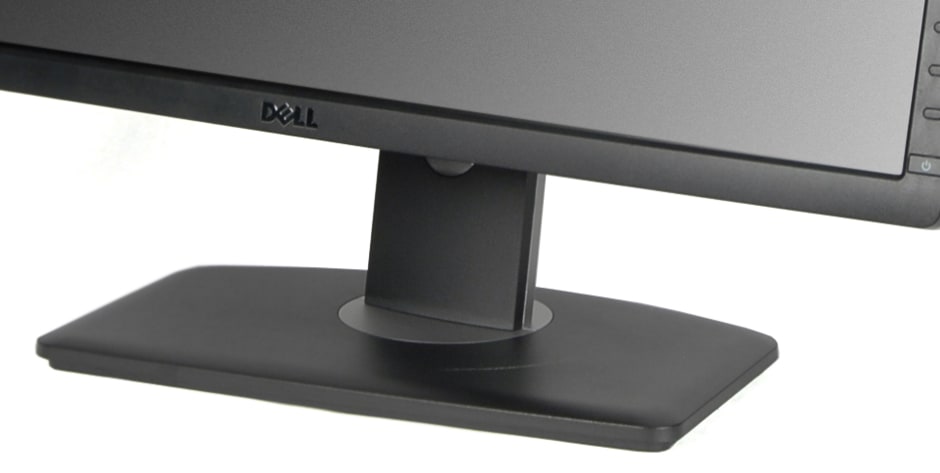Introduction
Overall Design
{{section_header}}{{section.name}}{{/section_header}}
The {{product.name}} has a clean, straightforward design that takes up a minimum of space on the desk. The panel is thin (at just over 2.5 inches) and the stand is small and easy to use.
Front
{{section_header}}{{section.name}}{{/section_header}}
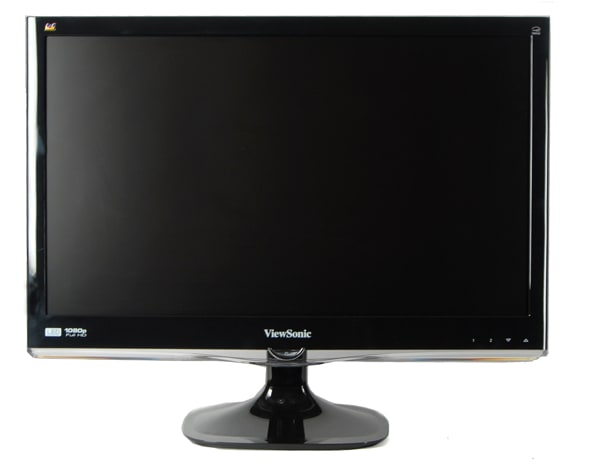
Back
{{section_header}}{{section.name}}{{/section_header}}

Side
{{section_header}}{{section.name}}{{/section_header}}
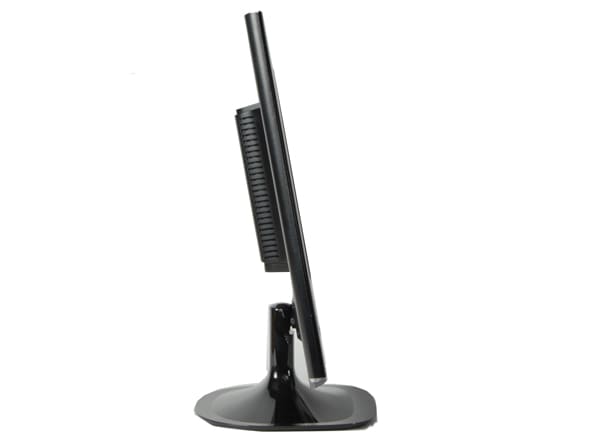
Stand
{{section_header}}{{section.name}}{{/section_header}}
The stand is somewhat smaller and lighter than most that we see, but still retains a good degree of control over the position of the panel. It can move up by 4 inches, tilt back by about 20 degrees and forwards by 5, rotate the display around by about 50 degrees and rotate the panel to portrait orientation. One issue that we found was that if you rotate the panel to portrait mode without tilting it backwards, the bottom left corner hits the base of the stand, and can leave a scratch on the base. This is detailed in the set-up sheet and manual, but it is easy to forget when switching orientations.
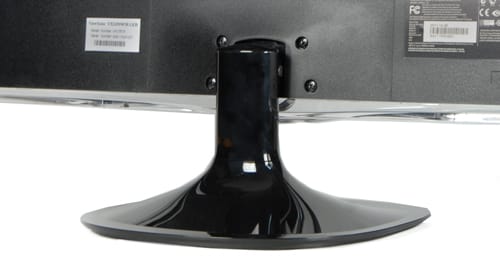
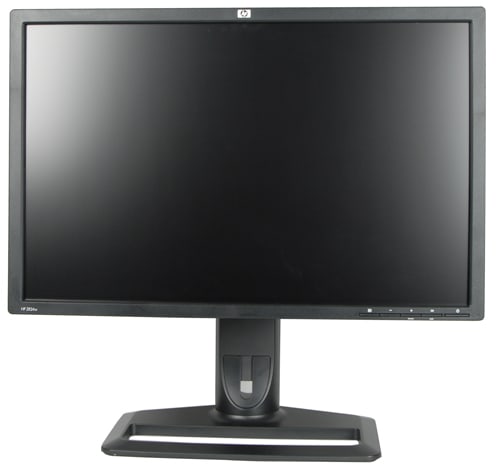
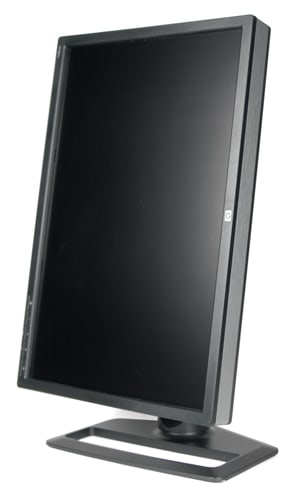
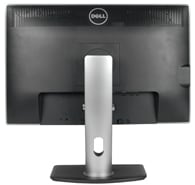
Controls
{{section_header}}{{section.name}}{{/section_header}}

In the Box
{{section_header}}{{section.name}}{{/section_header}}
As well as the display and the stand, you get:
- VGA cable
- DVI cable
- USB cable
- Power cable
- Software and drivers on CD
- Setup guide
No DisplayPort cables are included.
Contrast
{{section_header}}{{section.name}}{{/section_header}}
We found an acceptable contrast ratio from this display, with a black level of 1.02 cd/m2 and a peak white of 223.0. That leads to a contrast ratio of 219:1, which is somewhat less than some other displays. However, it is more than adequate for general use. More on how we test contrast.
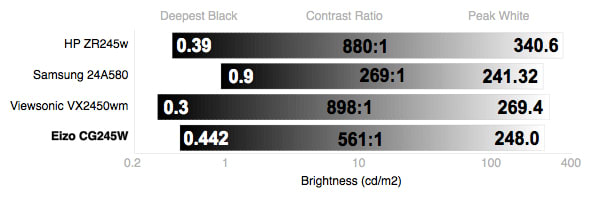
Uniformity
Color Temperature
{{section_header}}{{section.name}}{{/section_header}}
The color temperature of the whites produced from this display stayed pretty constant in our tests, with only some minor variations across the range of whites from light to nearly black. This means that the whites should stay consistent, with no visible color shifts. More on how we test color temperature.
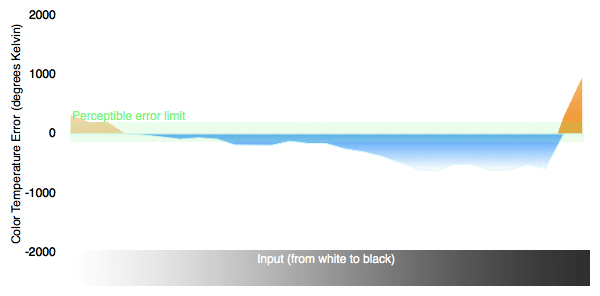
Color Curves
{{section_header}}{{section.name}}{{/section_header}}
We found a few issues here, with some subtle color changes not being accurately reproduced on the screen. On the graphs below, you see this as a blip in what should be a smooth curve on the graph. What this would mean is that you might see some banding or other glitches on color gradients, such as a blue sky or the colors of a flower. More on how we test color curves.
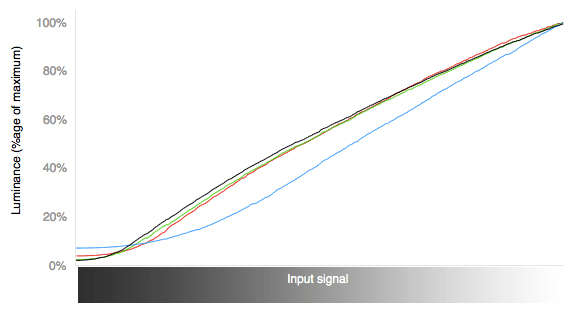
Color Gamut
{{section_header}}{{section.name}}{{/section_header}}
The color gamut of this monitor was also a little off. The color gamut of a monitor is the range of colors that it can accurately reproduce on screen, and we test to see how close it gets to the sRGB gamut that monitors are designed to comply with. This was a little off on the {{product.model}}, with both the red and blues being a little too wide, which would make reds and blues on screens look somewhat off. More on how we test color gamut.
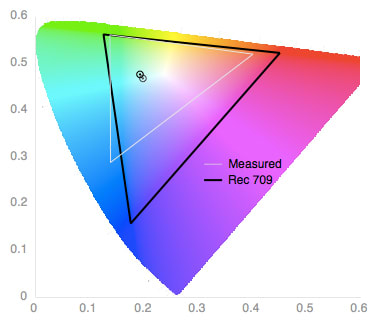
Viewing Angle
{{section_header}}{{section.name}}{{/section_header}}
The viewing angle of this display was acceptable, but not outstanding. We found that the contrast ratio fell by a lot at a 45 degree angle, dropping to 42:1. The colors remained stable, though, with little shift.
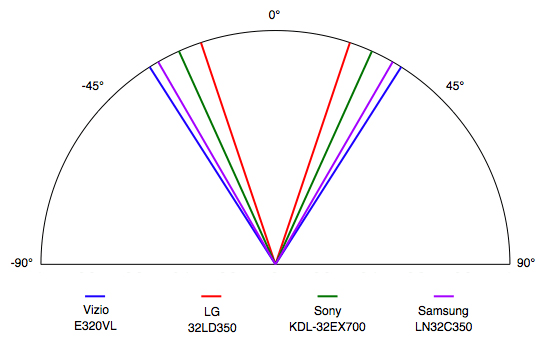
Calibration
{{section_header}}{{section.name}}{{/section_header}}
We calibrate all of the monitors that we test using an i1 Display Pro and the i1 Profiler software to produce an ICC profile. For the contrast, uniformity, and viewing angle test, we use the highest contrast ratio that the display can achieve, simulating using the display in a brightly lit environment where color fidelity is less critical (such as office use). For the color temperature, gamut and the color curves test, we calibrate the monitors to a luminance level of 80, simulating how a monitor would be set up in a professional design, photography or printing environment. So, please note that the performance in the contrast, uniformity and viewing angle tests reflects what you would get in an office setting, while the other test reflect the performance you would achieve. The settings that we use for our color tests are below: these were set by the i1 Profiler software during the calibration process using ADC (Auto Display Control).
Connectivity
{{section_header}}{{section.name}}{{/section_header}}
The {{product.model}} offers a good selection of inputs, with one DVI, VGA and DisplayPort. There are no HDMI or analog video inputs, though. The ports are a little hard to reach, and are not labelled, so you really need to rotate the monitor to portrait orientation and turn it around to plug in or remove a cable.
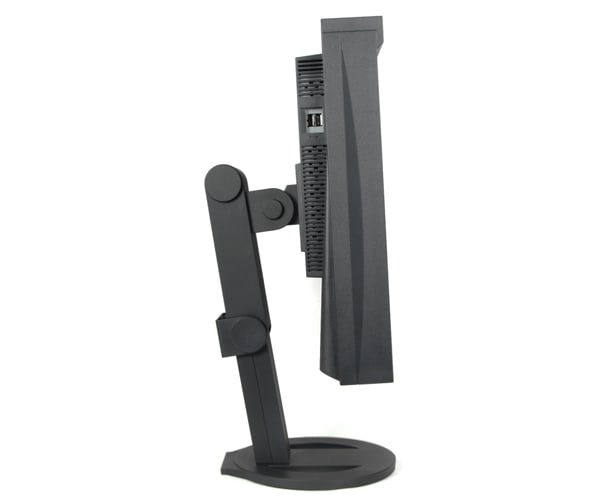

Controls & Menus
{{section_header}}{{section.name}}{{/section_header}}
The controls are located on the right side of the bezel, with only the power button being labelled. The function of the others depends on where you are in the on-screen menu, with an icon next to them indicating what they do. They can also be programmed to perform specific functions when pressed outside of the on-screen menu, which is a useful technique if you want to quickly access a specific control or feature.

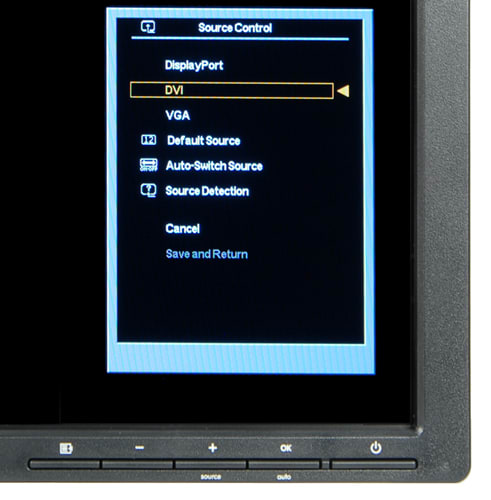
Other Features
{{section_header}}{{section.name}}{{/section_header}}
4-port USB Hub - a 4-port USB 2.0 hub is built into this device, with two USB ports on the back and two on the side of the body. This is a good approach allowing you to connect permanently used devices to the back and often removed devices like USB thumb drives to the side. We would have liked to have seen support for the newer and faster USB 3.0 standard, but this is only offered on a few monitors.
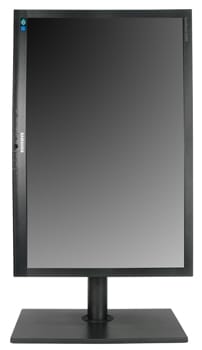
The LS24A850DW in portrait orientation
Comparison Overview
{{section_header}}{{section.name}}{{/section_header}}
The Dell UltraSharp U2412M is the better performing monitor in most of our tests, scoring higher across the board in our performance tests. It also has a wider selection of ports than the Viewsonic, offering a DisplayPort in addition to the standard DVI and VGA ports. What the Viewsonic has in its favor is a set of speakers and price: the Viewsonic is much cheaper at under $200.
Comparison Overview
{{section_header}}{{section.name}}{{/section_header}}
The Samsung LS24A850DW is the more expensive of these two monitors, but it was a pretty close battle between them in our performance tests. The Dell was the better performer in some tests (such as color temperature), while the Samsung was the better in others. The Samsung was definitely the better designed monitor, though, with a stand that was more flexible and felt more robust than the Dell. For one thing, you can't scratch the base of the Samsung when rotating the panel to portrait orientation, while we found ourselves doing this a lot with the Dell.
Comparison Overview
{{section_header}}{{section.name}}{{/section_header}}
The HP ZR24w and the Dell UltraSharp U2412M are both mid-range monitors that offer a good range of features for a similar price. Both performed well in our tests, with only minor differences between the two. Physically, the two are quite different, though, with the Dell being much thinner and smaller. So, if you prefer the look of the Dell, it's a good pick.
Conclusion
{{product.vanity}}
The {{product.name}} is a sleek, smart monitor that offers the features that most users are going to need, including a good selection of ports and good image quality. But it has some issues: the stand looks great, but is annoying to switch orientations with and got quickly scratched in our tests.
Photo Gallery
{{photo_gallery "Front Image", "Back Image", "Side Image", "Stand Photo", "Stand A", "Stand B", "Stand C", "Controls Photo", "Connectivity Photo 1", "Connectivity Photo 2", "Menu Photo", "Controls Photo"}}
Meet the tester
Richard Baguley is a veteran writer who has written about technology ranging from Alphabet to Zip file utilities. He has contributed to pretty much every major tech publication, including Amiga Format Magazine, PC World, Wired, CNET, Toms Guide, Forbes, and many others. He lives in the Boston metro area with his wife, dog, and an indeterminate number of cats.
Checking our work.
Our team is here to help you buy the best stuff and love what you own. Our writers, editors, and experts obsess over the products we cover to make sure you're confident and satisfied. Have a different opinion about something we recommend? Email us and we'll compare notes.
Shoot us an email